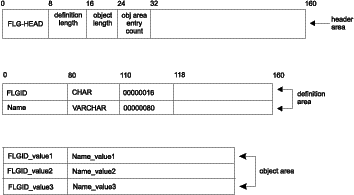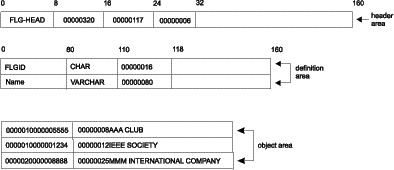
Retrieves a list of all anchor instances for the Grouping category. Anchors are Grouping category objects that have containees, but are not contained by other objects.
Authorization
Administrator or user
Syntax
APIRET APIENTRY FLGListAnchors( PFLGHEADERAREA * ppListStruct,
PFLGEXTCODE pExtCode );
Parameters
The output structure contains the following information for each anchor object instance:
All instances are sorted according to the collating sequence of the database used for your information catalog, first by object type name, then by Name.
The maximum number of object instances that can be returned by FLGListAnchors is 1600.
See Appendix D, Information Catalog Manager reason codes for an explanation of the returned reason codes.
Output structure
FLGListAnchors produces an output structure containing a list of anchors, as shown in Figure 86.
The object area of the output structure contains a list of anchor object instances, identified by the value of the FLGID and the external name for each object instance.
Figure 86. FLGListAnchors output structure

Usage
Freeing memory allocated for an output structure
If FLGListAnchors returned data in the output structure, you must save the data returned in the output structure and then call FLGFreeMem (see FLGFreeMem). Do not use other methods, for example, C language instructions, to free memory.
Figure 87 shows the C language code required to invoke the FLGListAnchors API call. This sample code retrieves a list of the anchors in your information catalog.
Figure 87. Sample C language call to FLGListAnchors
APIRET rc; // reason code from FLGListAnchors
PFLGHEADERAREA * ppListStruct; // pointer to output structure pointer
FLGEXTCODE ExtCode=0; // Extended code
.
.
rc = FLGListAnchors (ppListStruct, // address of output structure pointer
&ExtCode);
Figure 88 shows the output structure.
Figure 88. Sample output structure for FLGListAnchors
